The 1950s were
a time of great change in America. People, especially homemakers,
tired of scrimping and saving throughout the Great Depression and
then World War II, were looking for an easier time of it. And
nothing exemplified that more than Horn and Hardart, a chain of
automated restaurants that would change the way some people would
eat forever.
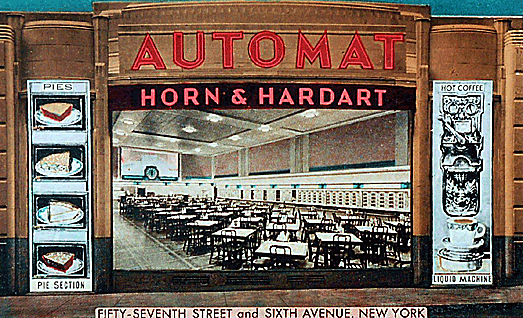
How It All Began
Long before such fast-food giants as McDonald’s and Burger King,
there was Horn & Hardart. People looked upon the company’s
coin-operated Automats as a sign of progress. Wonders of speed and
efficiency, the restaurant chain quickly grew into the world’s
largest, serving 800,000 people a day in its cavernous, serverless
restaurants serving hot, fresh food through vending machines and
cafeterias. Making their debut in Philadelphia in 1902, just up the
street from Independence Hall, and reaching Manhattan in 1912, Horn
& Hardart Automats became an American icon.
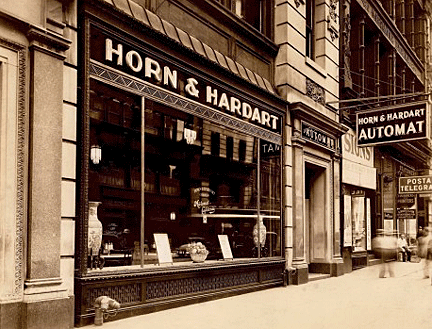 Customers
could assemble their own meals in a continuous moving operation.
Though the word "automat" comes from the Greek automatos, meaning
"self-acting," Horn and Hardart’s Automats were far from automatic.
As a customer removed a compartment’s contents, a behind-the-machine
human quickly slipped another sandwich, salad, piece of pie or
coffee cake into the empty compartment.
Customers
could assemble their own meals in a continuous moving operation.
Though the word "automat" comes from the Greek automatos, meaning
"self-acting," Horn and Hardart’s Automats were far from automatic.
As a customer removed a compartment’s contents, a behind-the-machine
human quickly slipped another sandwich, salad, piece of pie or
coffee cake into the empty compartment.
Joseph Horn and German-born New Orleans-raised Frank Hardart opened
their first restaurant together in Philadelphia, on December 22,
1888. Their tiny lunchroom at 39 South 13th Street had only a
counter with 15 stools. By introducing Philadelphia to New
Orleans-style coffee, blended with chicory, which Hardart promoted
as their "gilt-edge" brew, they made their little luncheonette a
local attraction. As people heard about Horn and Hardart’s coffee,
the business flourished. Ten years later, they incorporated as the
Horn & Hardart Baking Company.
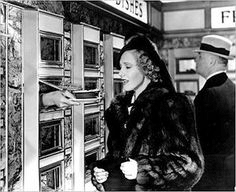 Inspired
by Max Sielaff's AUTOMAT Restaurants in Berlin, Horn and Hardart
became the first non-Europeans to receive patented vending machines
from Max Sielaff's AUTOMAT GmbH Berlin factory, creators of the
first chocolate bar vending machine. They opened their first automat
in the United States on June 12, 1902, at 818 Chestnut Street in
Philadelphia. The first New York Automat opened in Times Square July
2, 1912. Later that week, they opened a second one at Broadway and
East 14th Street, near Union Square.
Inspired
by Max Sielaff's AUTOMAT Restaurants in Berlin, Horn and Hardart
became the first non-Europeans to receive patented vending machines
from Max Sielaff's AUTOMAT GmbH Berlin factory, creators of the
first chocolate bar vending machine. They opened their first automat
in the United States on June 12, 1902, at 818 Chestnut Street in
Philadelphia. The first New York Automat opened in Times Square July
2, 1912. Later that week, they opened a second one at Broadway and
East 14th Street, near Union Square.
In 1924, Horn & Hardart opened retail stores to sell prepackaged
automat favorites. Using the advertising slogan, "Less Work for
Mother," the company popularized the notion of easily served
"take-out" food as an equivalent to "home-cooked" meals.
Those Were the Good Ole Days
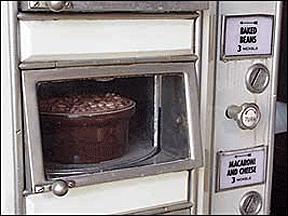 Customers
assembled their own meals in a continuous, moving operation.
Customers could see the food before purchasing it through
glass-fronted compartments and the shiny fittings appeared to be
more sanitary. Marble counters and floors, stained glass, chrome
fixtures, ornately carved ceilings, and Art Deco signage made Horn
and Hardart’s Automats seem more like Parisian bistros than sterile
fast-food outlets. Customers received their food on real china and
ate it with solid flatware.
Customers
assembled their own meals in a continuous, moving operation.
Customers could see the food before purchasing it through
glass-fronted compartments and the shiny fittings appeared to be
more sanitary. Marble counters and floors, stained glass, chrome
fixtures, ornately carved ceilings, and Art Deco signage made Horn
and Hardart’s Automats seem more like Parisian bistros than sterile
fast-food outlets. Customers received their food on real china and
ate it with solid flatware.
In huge rectangular halls filled with shiny, lacquered tables, women
with rubber tips on their fingers, known as “nickel throwers," sat
in glass booths and gave customers the nickels required to operate
the food machines in exchange for larger coins and paper money.
Customers scooped up their nickels, then slipped them into slots in
the Automats and turned the chrome-plated knobs with their porcelain
centers. In a few seconds the compartment next to the slot revolved
into place to present the desired cold food to the customer through
a small glass door that opened and closed. Diners picked up hot
foods at buffet-style steam tables.

The company discouraged its patrons from tipping. Nor did any cash
register reveal the cost of a meal for all to see. The coin slots
kept thrifty customers’ dining expenditures discreetly hidden.
For those diners who were really in a rush, the company provided
stand-up counters similar to those that banks provide for writing
deposit slips where customers could eat what came to be known as
"perpendicular meals."
Lots of Food Items to Choose From
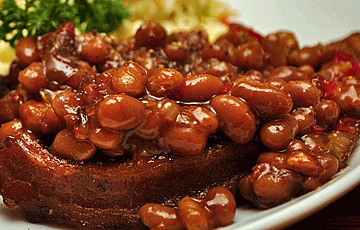 During
the Great Depression, macaroni and cheese, baked beans, and creamed
spinach were staple offerings at the Automats. Soon, sandwiches,
slices of pie, chicken potpie, fish cakes, buns, and tapioca pudding
joined the menu which eventually offered 400 choices. Eventually,
the Automats served lunch and dinner entrees, such as beef stew and
Salisbury steak with mashed potatoes.
During
the Great Depression, macaroni and cheese, baked beans, and creamed
spinach were staple offerings at the Automats. Soon, sandwiches,
slices of pie, chicken potpie, fish cakes, buns, and tapioca pudding
joined the menu which eventually offered 400 choices. Eventually,
the Automats served lunch and dinner entrees, such as beef stew and
Salisbury steak with mashed potatoes.
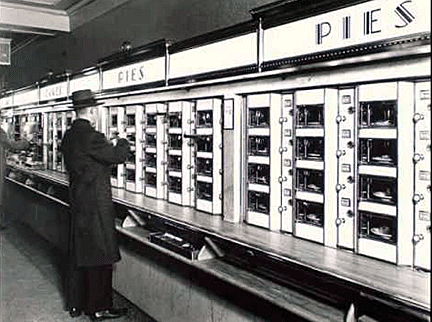 These
were popular, busy restaurants, where in the late 1950s, for under
$1.00, patrons could enjoy a large meal that fit their budget. Each
stack of glass-doored dispensers had a metal cylinder that could be
rotated by the staff on the other side of the vending wall, hiding
the contents while they refilled each dispenser in the stack with a
plate of salad, pudding, meat, or vegetables. Each dispenser had a
slot for one or more nickels, and a knob to rotate the nickels out
of view into the internal cash box and to allow the glass door to be
raised up and locked in a horizontal position for easy removal of
the plate or bowl of food. More expensive items required tokens
valued up to 75˘ which customers could obtain from the cashier. Some
of the rectangular dispensers offered hot food, others cold choices.
These
were popular, busy restaurants, where in the late 1950s, for under
$1.00, patrons could enjoy a large meal that fit their budget. Each
stack of glass-doored dispensers had a metal cylinder that could be
rotated by the staff on the other side of the vending wall, hiding
the contents while they refilled each dispenser in the stack with a
plate of salad, pudding, meat, or vegetables. Each dispenser had a
slot for one or more nickels, and a knob to rotate the nickels out
of view into the internal cash box and to allow the glass door to be
raised up and locked in a horizontal position for easy removal of
the plate or bowl of food. More expensive items required tokens
valued up to 75˘ which customers could obtain from the cashier. Some
of the rectangular dispensers offered hot food, others cold choices.
The Best Coffee in Town
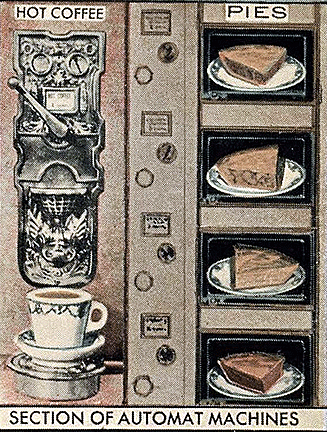 Horn
& Hardart’s coffee became known as the best in town. Horn & Hardart
introduced the first fresh-drip brewed coffee to Philadelphia and
New York. In their heyday in the 1950s, Automats sold more than 90
million cups of fresh-brewed coffee each year. From 1912 to 1950, a
cup cost a nickel.
Horn
& Hardart’s coffee became known as the best in town. Horn & Hardart
introduced the first fresh-drip brewed coffee to Philadelphia and
New York. In their heyday in the 1950s, Automats sold more than 90
million cups of fresh-brewed coffee each year. From 1912 to 1950, a
cup cost a nickel.
The coffee flowed from silver dolphin spouts that Joseph Horn found
in Italy. And that French-drip coffee, always piping hot and potent,
was Horn & Hardart’s most popular item. It was freshly brewed every
20 minutes, and until 1950 it cost only a nickel a cup.
After brewing each batch of their coffee, Horn & Hardart employees
filled out a time card. After 20 minutes, they discarded whatever
coffee remained and prepared more. Irving Berlin, the composer of
"God Bless America," wrote a famous song about this delicious brew,
"Let’s Have Another Cup of Coffee," which became Horn & Hardart’s
theme song.
Quality Always Came First
 While
Horn & Hardart Automats delivered food quickly, workers behind the
scenes prepared meals from scratch using fresh, high-quality
ingredients. They refilled food compartments as they emptied, thus
insuring freshness, and they didn’t allow food to linger overnight.
Workers poured freshly squeezed orange juice that sat for two hours
down the drain. After closing time each day, Horn & Hardart trucks
carried surplus food to "day-old" shops. New York and Philadelphia
each had three, located in low-income neighborhoods, which sold
these items at reduced prices.
While
Horn & Hardart Automats delivered food quickly, workers behind the
scenes prepared meals from scratch using fresh, high-quality
ingredients. They refilled food compartments as they emptied, thus
insuring freshness, and they didn’t allow food to linger overnight.
Workers poured freshly squeezed orange juice that sat for two hours
down the drain. After closing time each day, Horn & Hardart trucks
carried surplus food to "day-old" shops. New York and Philadelphia
each had three, located in low-income neighborhoods, which sold
these items at reduced prices.
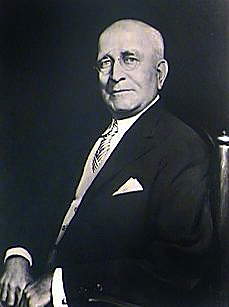 Horn
and Hardart enforced quality control. They gave each manager a
leather-bound rule book which listed the proper handling of all menu
items. It also described precisely where to position the
buffet-style food on the plates and stated the number of times
employees were to wipe tabletops each day.
Horn
and Hardart enforced quality control. They gave each manager a
leather-bound rule book which listed the proper handling of all menu
items. It also described precisely where to position the
buffet-style food on the plates and stated the number of times
employees were to wipe tabletops each day.
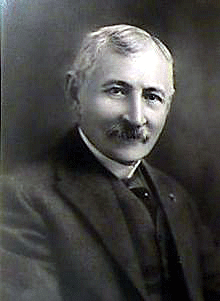 Founders
Horn and Hardart and other executives lunched together daily at the
Sample Table to test for quality and uniformity. They ate regular
menu items and offered suggestions for new ones. And they judged
whether new ingredients that outside suppliers offered were superior
to those they were already using.
Founders
Horn and Hardart and other executives lunched together daily at the
Sample Table to test for quality and uniformity. They ate regular
menu items and offered suggestions for new ones. And they judged
whether new ingredients that outside suppliers offered were superior
to those they were already using.
Between courses, samplers sipped black coffee, which came from a
different Horn & Hardart Automat each day. In this way, Horn &
Hardart performed spot checks on coffee, their most popular item.
The precise amount gushed from the mouth of a chrome dolphin’s head,
copied from a Pompeian fountain, at an exactly calibrated
temperature.
A Victim of Changing Tastes
Unfortunately, Horn and Hardart Automats fell victim to consumers’
changing tastes. Many no longer ate a full meal at lunch. If they
did, they had more money to eat at sit-down restaurants. Americans
moved into the suburbs and didn’t come downtown as often, so night
business at Automats fell off. With lower labor and food costs,
modern fast-food restaurants, such as McDonald’s and Burger King,
offered too much competition.
